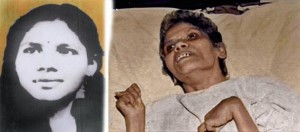 The Supreme Court has rejected Pinki Virani’s plea for mercy killing of Aruna Shanbaug. The court rejected the case and laid guidelines for mercy killing in extreme cases of terminally ill patients. Aruna Shanbaug, is lying in a “persistent vegetative state” in Mumbai’s KEM Hospital for over 37 years after a brutal sexual assault. The apex court laid down guidelines for passive euthanasia like stopping life support system. It said such a plea made by patients or relatives must be examined by expert doctors and placed before the concerned high court, which will take the final decision. This SC guideline would hold till Parliament enacts a law on euthanasia.
The Supreme Court has rejected Pinki Virani’s plea for mercy killing of Aruna Shanbaug. The court rejected the case and laid guidelines for mercy killing in extreme cases of terminally ill patients. Aruna Shanbaug, is lying in a “persistent vegetative state” in Mumbai’s KEM Hospital for over 37 years after a brutal sexual assault. The apex court laid down guidelines for passive euthanasia like stopping life support system. It said such a plea made by patients or relatives must be examined by expert doctors and placed before the concerned high court, which will take the final decision. This SC guideline would hold till Parliament enacts a law on euthanasia.
Does Aruna Shanbaug deserve to die? Journalist Pinki Virani believes so. She says Ms Shanbaug should be freed from the indignity and suffering that she has endured for the past 36 years. Confined to a hospital bed after being nearly strangled with a bicycle chain by her rapist, she has been in what doctors call a “persistent vegetative state” – severe brain damage, but not in a coma for most of the time since November 1973.
Ms Shanbaug, now 61, is unable to hear much, barely able to move and understands very little. She’s force-fed dutifully twice a day and kept alive by nurses. She used to be one herself. Life mocks her every living moment: refusing to leave her, it condemns her into a humiliating compromise – a netherworld between life and death.
So Ms Virani, author of a chilling book on Ms Shanbaug, has now petitioned the Supreme Court with a plea that she be allowed to die – if she is not fed for a few days, she says, the former nurse will stop living. Mercy killing is illegal in India, so it will be interesting to see how the Supreme Court handles what could turn out to be a landmark case.
Ms Shanbaug’s condition brings to mind two similar, high-profile cases in recent times.
Last year Italy’s top court awarded a man the right to disconnect the feeding tube that kept his comatose daughter alive for 16 years. And in 2005, a brain-damaged Florida woman Terri Schiavo died after her feeding tube was removed, following a seven-year legal battle between her husband and parents. Ms Schiavo had been in a vegetative state for some 15 years.
Euthanasia is a contentious issue the world over – the Economist magazine once said that “few laws have been drafted to regulate the delivery of death”. The Netherlands was the first country in the world to legalise euthanasia seven years ago. In Italy, euthanasia is illegal, but Italian law upholds a patient’s right to refuse care and the potential contradiction has led to thorny legal disputes. Passive euthanasia is possible in Sweden following new medical guidelines allowing doctors to halt life-extending treatment if the patient asks. Germany has a fuzzy law on assisted suicide – it is legal, but it cannot involve a doctor because it would violate his Hippocratic oath. And in Switzerland, assisted suicide is legal and non-physicians can be involved.
India lags far behind on the issue of euthanasia or assisted suicide. In a country where attempting to take one’s life remains a criminal offence, it is difficult to see a court venturing into the minefield of the right-to-die issue. A prominent right-to-die activist said years ago that an Indian court “is not yet geared to the concept of allowing a person to be assisted in suicide.” No wonder no human rights lawyer has taken up Ms Shanbaug’s case in the past 36 years.
Also, I wonder whether the overburdened legal system will have the stamina to examine the merits of Ms Virani’s brave petition: the Supreme Court alone has a backlog of over 50,000 cases. But if the courts revisit the country’s derelict laws and help trigger a debate on whether euthanasia or assisted suicide could be negotiated in a complex society like India’s, Ms Shanbaug’s life in indignity would not have been in vain.




















It’s hard to find your website in google. I found it on 13
spot, you should build quality backlinks , it will help you to increase traffic.
I know how to help you, just type in google – k2 seo tricks